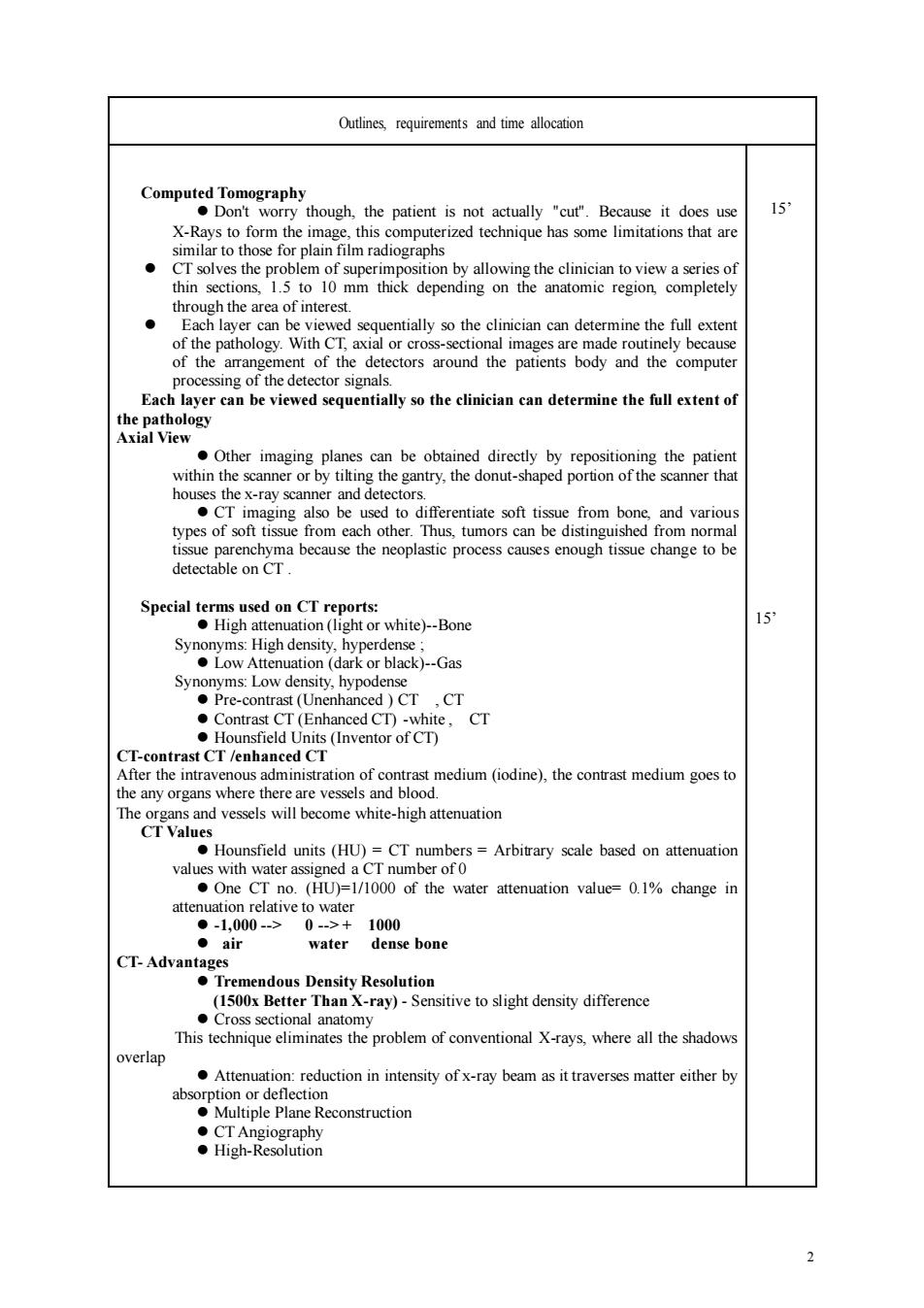正在加载图片...

Outlines requirements and time allocation 15 X-Rays to ,csmc的 thin sections.1.5 to 10mm thick depending on the anatomic region completely I images a inely because Each layer can be viewed sequentially so the clinician can determine the full extent of hivoy Other imaging planes can be obtained directly by repositioning the patient hscaner or bytin the gantry,the donut-shaped poron of the scanner tha soft tissue from bone and variou ypes of soft ticthc dingushed fo detectable on CT neoplastic process causes enough tis white)-Bone 15 -om Sy Cnta (nventor re.CT The Ce One CT no.(HU)=1/1000 of the water attenuation value-0.1%change in .1000 air water dense bone 不袖二款aa verlap :reduction in intensity ofx-ray beam as ittraverses matter either by High-Resolution2 Outlines, requirements and time allocation Computed Tomography ⚫ Don't worry though, the patient is not actually "cut". Because it does use X-Rays to form the image, this computerized technique has some limitations that are similar to those for plain film radiographs ⚫ CT solves the problem of superimposition by allowing the clinician to view a series of thin sections, 1.5 to 10 mm thick depending on the anatomic region, completely through the area of interest. ⚫ Each layer can be viewed sequentially so the clinician can determine the full extent of the pathology. With CT, axial or cross-sectional images are made routinely because of the arrangement of the detectors around the patients body and the computer processing of the detector signals. Each layer can be viewed sequentially so the clinician can determine the full extent of the pathology Axial View ⚫ Other imaging planes can be obtained directly by repositioning the patient within the scanner or by tilting the gantry, the donut-shaped portion of the scanner that houses the x-ray scanner and detectors. ⚫ CT imaging also be used to differentiate soft tissue from bone, and various types of soft tissue from each other. Thus, tumors can be distinguished from normal tissue parenchyma because the neoplastic process causes enough tissue change to be detectable on CT . Special terms used on CT reports: ⚫ High attenuation (light or white)-Bone Synonyms: High density, hyperdense ; ⚫ Low Attenuation (dark or black)-Gas Synonyms: Low density, hypodense ⚫ Pre-contrast (Unenhanced ) CT , CT ⚫ Contrast CT (Enhanced CT) -white , CT ⚫ Hounsfield Units (Inventor of CT) CT-contrast CT /enhanced CT After the intravenous administration of contrast medium (iodine), the contrast medium goes to the any organs where there are vessels and blood. The organs and vessels will become white-high attenuation CT Values ⚫ Hounsfield units (HU) = CT numbers = Arbitrary scale based on attenuation values with water assigned a CT number of 0 ⚫ One CT no. (HU)=1/1000 of the water attenuation value= 0.1% change in attenuation relative to water ⚫ -1,000 -> 0 -> + 1000 ⚫ air water dense bone CT- Advantages ⚫ Tremendous Density Resolution (1500x Better Than X-ray) - Sensitive to slight density difference ⚫ Cross sectional anatomy This technique eliminates the problem of conventional X-rays, where all the shadows overlap ⚫ Attenuation: reduction in intensity of x-ray beam as it traverses matter either by absorption or deflection ⚫ Multiple Plane Reconstruction ⚫ CT Angiography ⚫ High-Resolution 15’ 15’